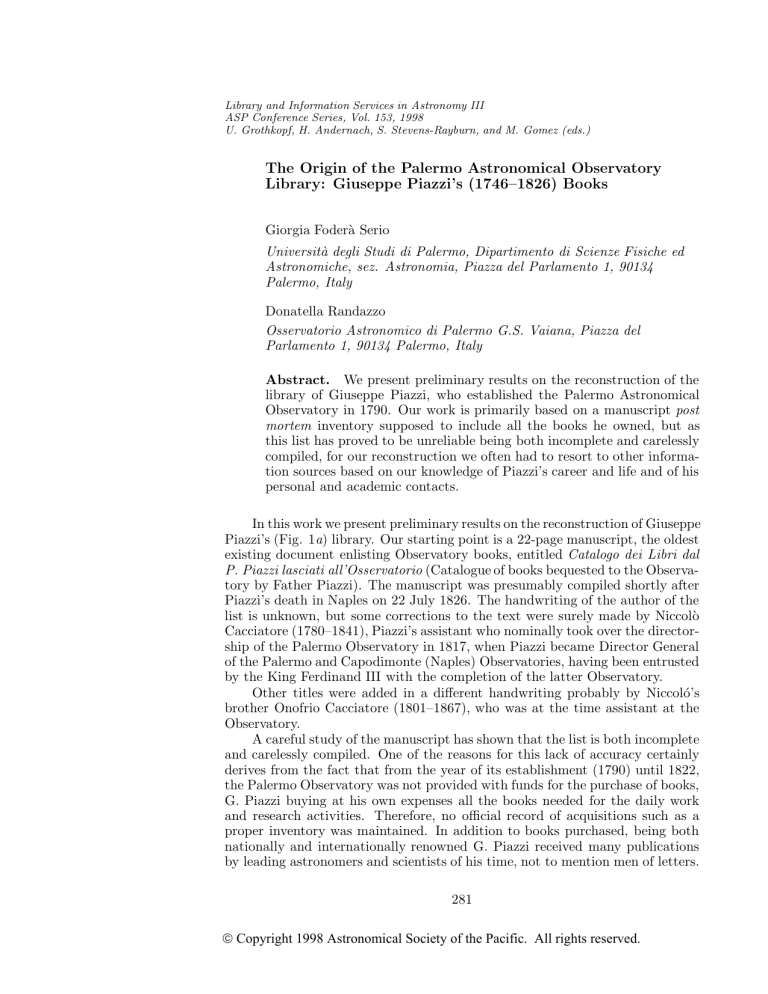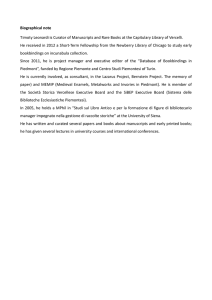Library and Information Services in Astronomy III

Library and Information Services in Astronomy III
ASP Conference Series, Vol. 153, 1998
U. Grothkopf, H. Andernach, S. Stevens-Rayburn, and M. Gomez (e ds.)
The Origin of the Palermo Astronomical Observatory
Library: Giuseppe Piazzi’s (1746–1826) Books
Astronomiche, sez. Astronomia, Piazza del Parlamento 1, 90134
Palermo, Italy
Donatella Randazzo
Osservatorio Astronomico di Palermo G.S. Vaiana, Piazza del
Parlamento 1, 90134 Palermo, Italy
Abstract.
We present preliminary results on the reconstruction of the library of Giuseppe Piazzi, who established the Palermo Astronomical
Observatory in 1790. Our work is primarily based on a manuscript post mortem inventory supposed to include all the books he owned, but as this list has proved to be unreliable being both incomplete and carelessly compiled, for our reconstruction we often had to resort to other information sources based on our knowledge of Piazzi’s career and life and of his personal and academic contacts.
In this work we present preliminary results on the reconstruction of Giuseppe
Piazzi’s (Fig. 1 a ) library. Our starting point is a 22-page manuscript, the oldest existing document enlisting Observatory books, entitled Catalogo dei Libri dal
P. Piazzi lasciati all’Osservatorio (Catalogue of books bequested to the Observatory by Father Piazzi). The manuscript was presumably compiled shortly after
Piazzi’s death in Naples on 22 July 1826. The handwriting of the author of the
Cacciatore (1780–1841), Piazzi’s assistant who nominally took over the directorship of the Palermo Observatory in 1817, when Piazzi became Director General of the Palermo and Capodimonte (Naples) Observatories, having been entrusted by the King Ferdinand III with the completion of the latter Observatory.
brother Onofrio Cacciatore (1801–1867), who was at the time assistant at the
Observatory.
A careful study of the manuscript has shown that the list is both incomplete and carelessly compiled. One of the reasons for this lack of accuracy certainly derives from the fact that from the year of its establishment (1790) until 1822, the Palermo Observatory was not provided with funds for the purchase of books,
G. Piazzi buying at his own expenses all the books needed for the daily work and research activities. Therefore, no official record of acquisitions such as a proper inventory was maintained. In addition to books purchased, being both nationally and internationally renowned G. Piazzi received many publications by leading astronomers and scientists of his time, not to mention men of letters.
281
Copyright 1998 Astronomical Society of the Pacific. All rights reserved.
282
Figure 1.
a) Giuseppe Piazzi (1746–1826); b) Giuseppe Piazzi’s exlibris.
His library was thus quite rich, if we also include the books he must have owned for his studies and teaching prior to the foundation of the Observatory.
It is our opinion that the compiler of the list, in the complete absence of any written record must have selected Piazzi’s books by merely applying straightforward criteria which presumably were the following:
1. Books bearing Piazzi’s ex-libris (Fig. 1 b ).
2. Books bearing personal dedications to Piazzi from the Author.
Despite the simpleness of these criteria, many mistakes were made and books bearing his ex-libris were missed either because not carefully checked or because this was partially hidden. Also books clearly dedicated to him were overlooked and not included. A clamorous ”absence” is Laplace’s Precis de l’Histoire de l’Astronomie with a dedication to Piazzi by the author.
In doubtful cases, i.e. when dedications did not explicitly state Piazzi’s name, or when the book was more generically addressed to the Director or the
Observatory, a third criterium was applied: the Observatory directorship in suborder).
The rationale behind the third criterium is that, no longer being the Director,
Piazzi had ceased to acquire publications for the Observatory and thus all new acquisitions were by default the property of the institution or the Director.
Origin of the Palermo Astronomical Observatory Library 283
This criterium strikes even more clearly in the list of serials included in the manuscript. As belonging to Piazzi, for instance, are indicated only the volumes of the Philosophical Transactions of the Royal Society of London or the
Turin published prior to 1817.
who often thought of himself as the true Director of the Observatory and forgot that as Director General Piazzi was still his superior. In any case, the proof that up until his death Piazzi continued to order and purchase books for the Observa-
Cacciatore’s handwriting it is stated that he went to Naples in August 1826 shortly after Piazzi’s death and found several pending orders made by Piazzi for instruments and books. Among the latter, for instance, the Philosophical
Transactions from 1816 to 1826.
The lack of care underlying the compilation of the manuscript appears even more remarkably if we consider later archival documents. A register entitled
Biblioteca del Reale Osservatorio (Library of the Royal Observatory) starts with two lists in the same handwriting, dated 18 June 1841 and endorsed by the signatures of the Palermo University Rector and the Observatory Director. The lists are respectively entitled: Catalogo dei libri lasciati da Piazzi al Real Osservatorio (i.e. the same title of Piazzi’s post mortem inventory), and Catalogo dei libri acquistati da Cacciatore al Real Osservatorio (Catalogue of the books purchased by Cacciatore for the Royal Observatory).
In theory, the former list should match the post mortem inventory, but a comparison shows numerous inconsistencies in that the 1841 list not only lacks about 100 of the 450 titles included in the earlier list, but also “adds” about 40 new titles. Among the absences, quite surprisingly, are Piazzi’s manuscripts (51 volumes) and observations, and 17 volumes of miscellaneous works.
A successive comparison of the above two lists with the list of Cacciatore’s acquisitions gives even more astonishing results, as many of the titles missing from the 1841 list are included there, thus originating double entries. In some cases the error in the double entry is easily spotted, for example being Bode’s Deen´ , an accompanying publication to Bode’s Uranographia which Piazzi had himself already purchased. The conclusion is that the entry in Cacciatore’s list is wrong.
The above incongruences all point to the fact that none of the lists considered is a reliable source of information on Piazzi’s holdings and that the information contained in the post mortem inventory throughout the years has somehow been degraded by the various attempts to reconstruct the library holdings. Therefore, in order to carry out a reconstruction which makes some sense, information sources other than the above lists must be sought. We are thus resorting to our knowledge of Piazzi’s career and life and of his personal and academic contacts.
An instance is given by a 1823 publication by Teodoro Monticelli, that is not included in any of the lists. Monticelli was Secretary of Accademia delle
Scienze di Napoli and good friend of Piazzi’s, who was the President of the same
Academy, thus it is highly likely that this publication was given to Piazzi by the author.
284
Through this approach we are also able to question some of the entries in
Cacciatore’s list even though these are not inconsistent with the two other lists.
For example, the 1822 publication by Scipione Breislak entitled Descrizione geologica di Milano was sent to Piazzi in 1823 by Barnaba Oriani (1752–1832),
Director of the Brera Astronomical Observatory and Piazzi’s best friend, as mentioned in their correspondence (1874).
However, in order to compile a preliminary catalogue of Giuseppe Piazzi’s library we have utilized the contents of the earlier manuscript because, though incomplete, they represent the primary source of official information. The large majority of the titles included in our catalogue match the manuscript entries, but we have also added and marked with an asterisk books that certainly belonged to G. Piazzi but were missed by the manuscript compiler. Our catalogue at this stage is a working draft of what was held in the earliest nucleus of the Palermo
Observatory Library.
Some preliminary data on the number of monographic works of Piazzi’s
Library are as follows: XVI Century
∼
18 ; XVII Century
∼
55; XVIII Century
∼
200; early XIX Century
∼
140. As far as serials (Journals, Ephemerides,
Memoirs) are concerned, titles of XVIII and XIX Centuries are
∼
40. The total number of volumes is around 1500.
From an approximate estimation, 80% of the above works are truly scientific, mainly Astronomy (30%), Physics (20%), Mathematics (20%) but also
Natural Sciences, Geography, Chemistry, Medicine. The remaining titles (20%) range from Philosophy to Religion, History and Local History and also include
Latin and Italian literature classics, dictionaries, grammars.
Among the Astronomy works: C. Ptolemy’s Almagestum (Venice, 1528), T.
Brahe’s Astronomiae Instauratae Progymnasmata (Frankfurt, 1610),
J.J. Lalande’s Astronomie (Paris, 1771), P.S. de Laplace’s Trait´ ecanique
C´ , (1798–1823).
Other scientific works include I. Newton’s Opera quae extant omnia (by S.
Horsley, London 1779), G.L. de Buffon’s Histoire Naturelle des Oiseaux (Paris,
1750–1751), J.A. Lepaute’s Trait´ (Paris, 1767), C.M. Carafa’s Exemplar Horologiorum Solarium Civilium (Mazzarino, 1689).
References
Catalogo dei Libri dal P. Piazzi lasciati all’Osservatorio , mss., Palermo Astronomical Observatory Archives (AI1/4).
Catalogo dei libri lasciati da Piazzi al Real Osservatorio , in Biblioteca del Reale
Osservatorio , mss., Palermo Astronomical Observatory Archives (AI1/7).
Catalogo dei libri acquistati da Cacciatore al Real Osservatorio , in Biblioteca del Reale Osservatorio , mss, Palermo Astronomical Observatory Archives
(AI1/7).
Corrispondenza astronomica fra Giuseppe Piazzi e Barnaba Oriani , Milano,
Napoli, Pisa, Ulrico Hoepli, 1874.
